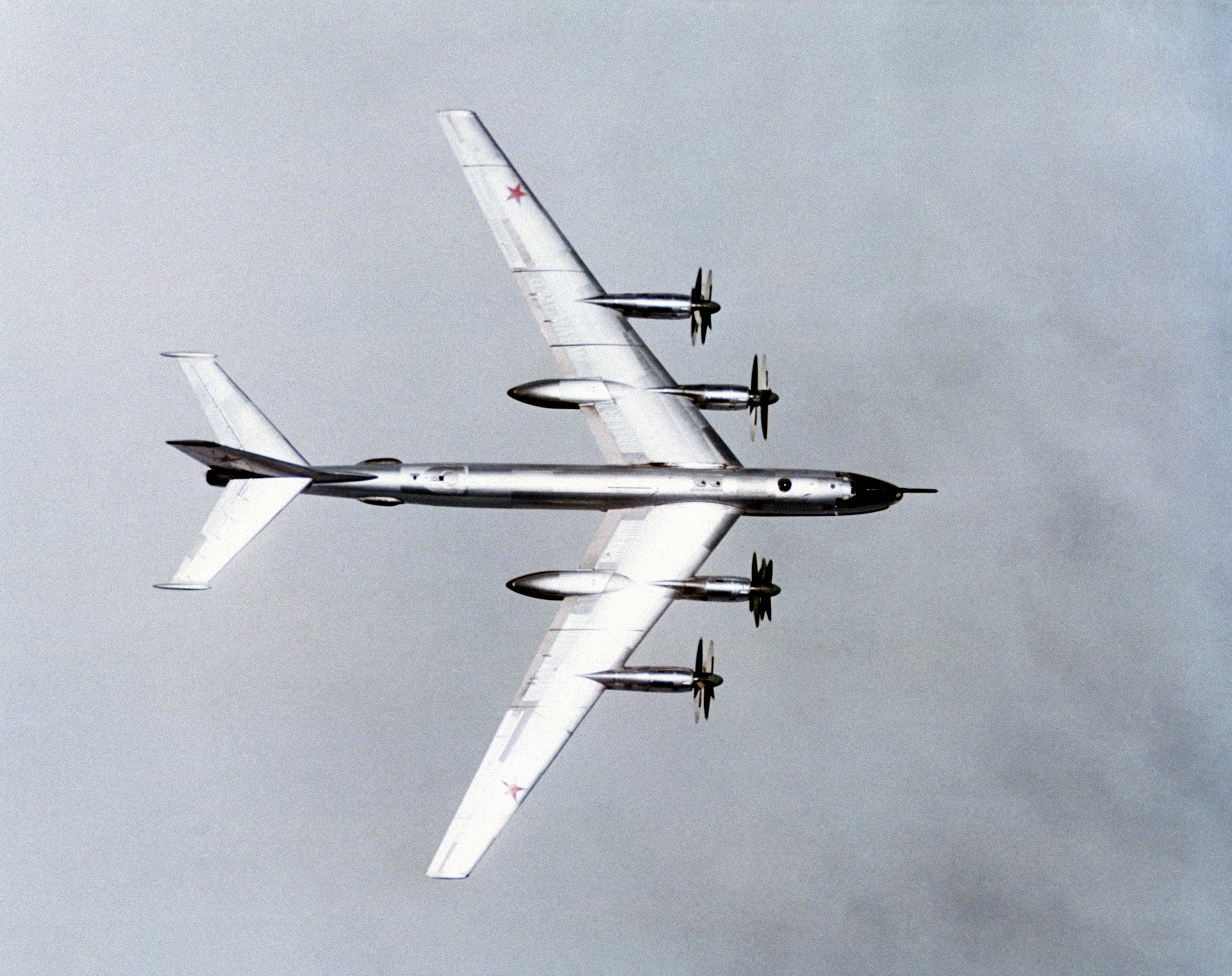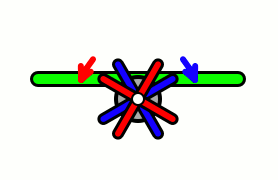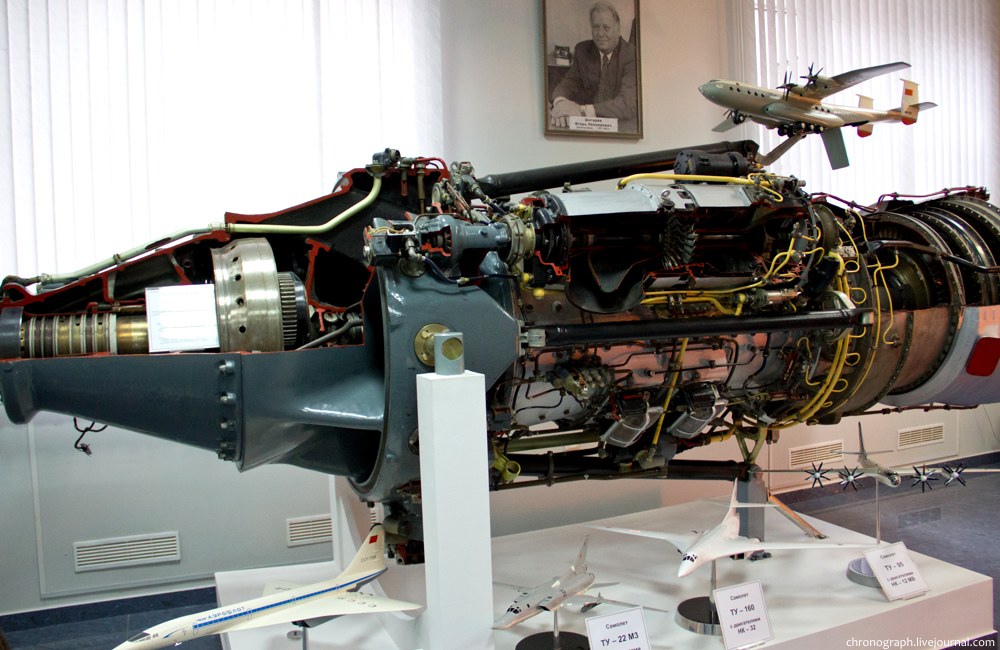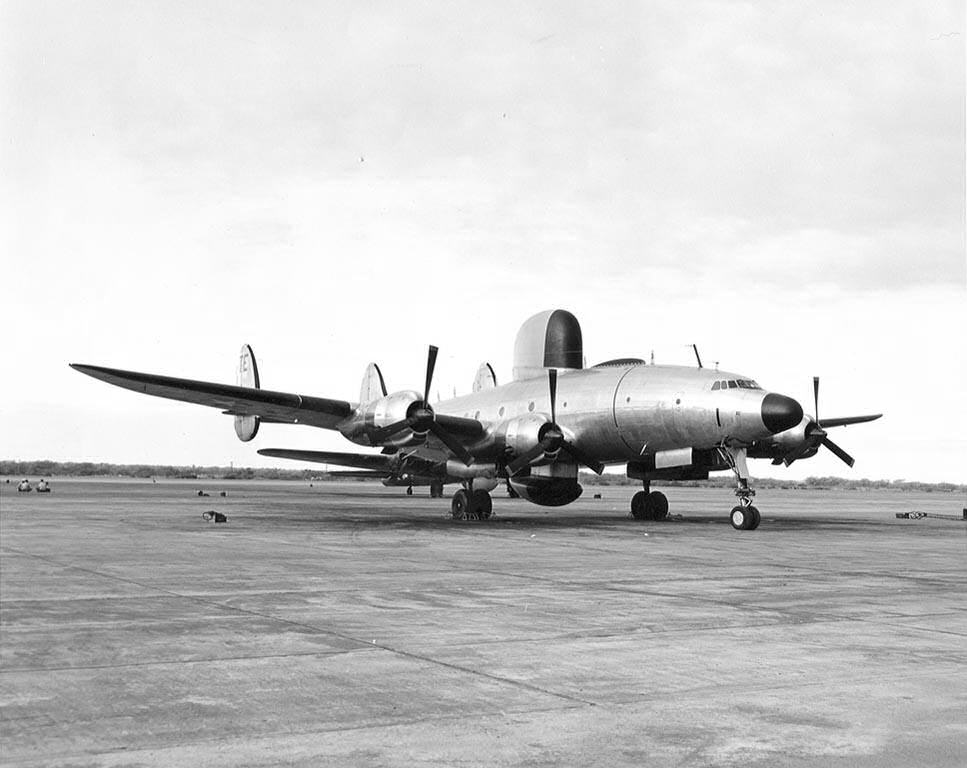|
Tu-126
The Tupolev Tu-126 (NATO reporting name: Moss) was an airborne early warning and control aircraft developed from the Tupolev Tu-114 airliner by the Tupolev design bureau. It was in service with the armed forces of the Soviet Union from 1965 to 1984. Design and development In 1958 increasing concern over the threat of an American nuclear strike against the USSR from the north led to a new requirement for an airborne radar system, which would avoid the problems and expense of attempting to create a land-based radar system to cover all of the enormous Soviet northern coast. The Tupolev Design Bureau was ordered to design an AEW&C aircraft. After trying to fit the projected radar instrumentation in a Tu-95 and a Tu-116, a decision was made to use the Tupolev Tu-114 with its wider fuselage instead. This solved problems with cooling and operator space that existed with the narrower Tu-95 and Tu-116 designs. To adhere to the flight range requirements, the plane was fitted with an air- ... [...More Info...] [...Related Items...] OR: [Wikipedia] [Google] [Baidu] |
Tupolev Tu-114
The Tupolev Tu-114 Rossiya ( ru , link=no, Tyполев Тy-114 Poccия; NATO reporting name Cleat) was a turboprop-powered long-range airliner designed by the Tupolev design bureau and built in the Soviet Union from May 1955. The aircraft was the largest and fastest passenger plane at that time and also had the longest range, at 10,900 km (6,800 mi). It has held the official title of fastest propeller-driven aircraft since 1960."FAI official database" '' Fédération Aéronautique Internationale''. Retrieved: 5 September 2007. Due to its swept wing and powerplant design, the Tu-114 was able to travel at speeds t ... [...More Info...] [...Related Items...] OR: [Wikipedia] [Google] [Baidu] |
Tupolev Tu-95
The Tupolev Tu-95 (russian: Туполев Ту-95; NATO reporting name: "Bear") is a large, four-engine turboprop-powered strategic bomber and missile platform. First flown in 1952, the Tu-95 entered service with the Long-Range Aviation of the Soviet Air Forces in 1956 and was first used in combat in 2015. It is expected to serve the Russian Aerospace Forces until at least 2040. A development of the bomber for maritime patrol is designated the Tu-142, while a passenger airliner derivative was called the Tu-114. The aircraft has four Kuznetsov NK-12 engines with contra-rotating propellers. It is the only propeller-powered strategic bomber still in operational use today. The Tu-95 is one of the loudest military aircraft, particularly because the tips of the propeller blades move faster than the speed of sound. Its distinctive swept-back wings are set at an angle of 35°. The Tu-95 is the only propeller-driven aircraft with swept wings that has been built in large numbers. De ... [...More Info...] [...Related Items...] OR: [Wikipedia] [Google] [Baidu] |
Contra-rotating Propellers
Aircraft equipped with contra-rotating propellers, also referred to as CRP, coaxial contra-rotating propellers, or high-speed propellers, apply the maximum power of usually a single piston or turboprop engine to drive a pair of coaxial propellers in contra-rotation. Two propellers are arranged one behind the other, and power is transferred from the engine via a planetary gear or spur gear transmission. Contra-rotating propellers are also known as counter-rotating propellers, although counter-rotating propellers is much more widely used when referring to airscrews on separate non-coaxial shafts turning in opposite directions. Operation When airspeed is low, the mass of the air flowing through the propeller disk (thrust) causes a significant amount of tangential or rotational air flow to be created by the spinning blades. The energy of this tangential air flow is wasted in a single-propeller design, and causes handling problems at low speed as the air strikes the vertical st ... [...More Info...] [...Related Items...] OR: [Wikipedia] [Google] [Baidu] |
Beriev A-50
The Beriev A-50 (NATO reporting name: Mainstay) is a Soviet airborne early warning and control (AEW&C) aircraft based on the Ilyushin Il-76 transport. Developed to replace the Tupolev Tu-126 "Moss", the A-50 first flew in 1978. Its existence was revealed to the Western Bloc in 1980 by Adolf Tolkachev.'' The Billion Dollar Spy: A True Story of Cold War Espionage and Betrayal'', David E. Hoffman, location 2330, Kindle edition. It entered service in 1984, with about 40 produced by 1992. Description The mission personnel of the 15-man crew derive data from the large Liana surveillance radar with its antenna in an over-fuselage rotodome, which has a diameter of Detection range is for air targets and for ground targets. The A-50 can control up to ten fighter aircraft for either air-to-air intercept or air-to-ground attack missions. The A-50 can fly four hours at from its base at a maximum takeoff weight of . The aircraft can be refuelled by Il-78 tankers. The radar "Vega-M" is ... [...More Info...] [...Related Items...] OR: [Wikipedia] [Google] [Baidu] |
Kuznetsov NK-12MV
The Kuznetsov NK-12 is a Soviet turboprop engine of the 1950s, designed by the Kuznetsov design bureau. The NK-12 drives two large four-bladed contra-rotating propellers, diameter (NK-12MA), and diameter (NK-12MV). It is the most powerful turboprop engine to enter service. Design and development The design that eventually became the NK-12 turboprop was developed after World War II by a team of Soviet scientists and deported German engineers under Ferdinand Brandner, who had worked for Junkers previously; the design bureau was headed by chief engineer Nikolai D. Kuznetsov. Thus, the NK-12 design evolved from late-war German turboprop studies. This started with the postwar development of the wartime Jumo 022 turboprop design that was designed to develop , weighing . The effort continued with a , weighing , completed by 1947. Evolution to the TV-12 engine required extensive use of new Soviet-developed alloys and was completed in 1951. The NK-12 is the most powerful turboprop ... [...More Info...] [...Related Items...] OR: [Wikipedia] [Google] [Baidu] |
Soviet Air Defence Forces
The Soviet Air Defence Forces (russian: войска ПВО, ''voyska protivovozdushnoy oborony'', ''voyska PVO'', ''V-PVO'', lit. ''Anti-Air Defence Troops''; and formerly ''protivovozdushnaya oborona strany'', ''PVO strany'', lit. ''Anti-Air Defence of the Country'') was the air defence branch of the Soviet Armed Forces. Formed in 1941, it continued being a service branch of the Russian Armed Forces after 1991 until it was merged into the Russian Air Force, Air Force in 1998. Unlike Western air defence forces, V-PVO was a branch of the military unto itself, separate from the Soviet Air Force (VVS) and Air Defence Troops of Ground Forces. During the Soviet period it was generally ranked third in importance of the Soviet services, behind the Strategic Rocket Forces and the Ground Forces. History Service during Second World War Preparations for creation of the air defence forces started in 1932, and by the beginning of Operation Barbarossa, June 1941, there were 13 PVO zones withi ... [...More Info...] [...Related Items...] OR: [Wikipedia] [Google] [Baidu] |
1984 In Aviation
This is a list of aviation-related events from 1984: Events * Cirrus Aircraft founded January * Frontier Horizon, a low-cost subsidiary of Frontier Airlines operating Boeing 727-100s, begins flight operations. * January 10 – A Balkan Bulgarian Airlines Tupolev Tu-134 strikes a power line and crashes on approach to Sofia Airport in Sofia, Bulgaria, in heavy snow, killing all 50 people on board. * January 24 – A United States Air Force F-15A Eagle performs the first of five test launches of the ASM-135 anti-satellite missile. In this first launch, the missile does not carry its third stage, the Miniature Homing Vehicle (MHV) interceptor.Dr. Raymond L. Puffer, ''The Death of a Satellite'' Retrieved on November 3, 2007. February * February 1 ** In the Iran–Iraq War, Iraq threatens air and missile attacks against Iranian cities, including Abadan, Ahwaz, Dezful, Ilam, and Kermanshah, and warns their residents to evacuate. ** Iraqi Air Force aircraft attack a convoy of f ... [...More Info...] [...Related Items...] OR: [Wikipedia] [Google] [Baidu] |
Yefim Gordon
Yefim Gordon (russian: Ефим Гордон, born 1950 in Vilnius, Soviet Union) is a Lithuanian aircraft photographer and author who specializes in Soviet aircraft and Russian aviation. Biography Gordon graduated in 1972 from the Polytechnic Institute Kaunas as an engineer / electronic technician. Since 1973 he lives in Moscow, where he collected as a hobby photographs and books on the history of Soviet aviation. This collection became a large archive. Since the 1980s he is a professional aviation journalist and writer. He has authored and co-authored about 100 books on Soviet and Russian aviation in Russian, English, Polish and Czech, published articles in nearly 100 journals and photo reports. He also works as a photographer. The 2018 edition of Jane's All The World's Aircraft shows 50 of his photographs. Gordon is co-owner of the Moscow aviation publisher Polygon Press Ltd. His works are also distributed by Midland publishing (now Ian Allan Publishing), Hikoki Publications ... [...More Info...] [...Related Items...] OR: [Wikipedia] [Google] [Baidu] |
EC-121 Warning Star
The Lockheed EC-121 Warning Star was an American airborne early warning and control radar surveillance aircraft operational in the 1950s in both the United States Navy (USN) and United States Air Force (USAF). The military version of the Lockheed L-1049 Super Constellation was used to serve as an airborne early warning system to supplement the Distant Early Warning Line, using two large radomes (a vertical dome above and a horizontal one below the fuselage). It replaced the TBM-3W used by the USN. Some EC-121s were also used for signal intelligence gathering. The EC-121 was introduced in 1954 and phased out in 1978, although a single specially modified EW aircraft remained in USN service until 1982. The USN versions when initially procured were designated WV-1 (PO-1W), WV-2, and WV-3. The USAF Warning Stars served during the Vietnam War both as electronic sensor monitors and as a forerunner to the Boeing E-3 Sentry AWACS. USAF aircrews adopted its civil nickname, "Connie" (d ... [...More Info...] [...Related Items...] OR: [Wikipedia] [Google] [Baidu] |
Šiauliai Air Base
Šiauliai Air Base is a Lithuanian Air Force base located near Šiauliai, Šiauliai County, Lithuania. Since 2004, it has been one of the bases of the Baltic Air Policing mission. It is connected to Šiauliai International Airport. History In 1931, an airfield was built in Šiauliai specifically for Lithuanian air forces. In 1940, after Soviet occupation of the Baltic states (1940) the airfield was placed at the disposal of the Red Army. June 22, 1941 aviation Wehrmacht and made a raid on the airfield, destroying a significant part of the Soviet aircraft there (including Polikarpov I-15 and Polikarpov I-16). During the war, the Germans used the forced labor of Lithuanian Jews to maintain the airfield. After the war, the airfield was expanded and specially transformed for the needs of Soviet aviation: by 1957, two large runways were built. In 1955, Šiauliai Airfield was one of six Soviet airfields that could receive intercontinental strategic bombers M-4 with nuclear weapons on ... [...More Info...] [...Related Items...] OR: [Wikipedia] [Google] [Baidu] |
Soviet Air Forces
The Soviet Air Forces ( rus, Военно-воздушные силы, r=Voyenno-vozdushnyye sily, VVS; literally "Military Air Forces") were one of the air forces of the Soviet Union. The other was the Soviet Air Defence Forces. The Air Forces were formed from components of the Imperial Russian Air Service in 1917, and faced their greatest test during World War II. The groups were also involved in the Korean War, and dissolved along with the Soviet Union itself in 1991–92. Former Soviet Air Forces' assets were subsequently divided into several air forces of former Soviet republics, including the new Russian Air Force. "March of the Pilots" was its song. Origins The ''All-Russia Collegium for Direction of the Air Forces of the Old Army'' (translation is uncertain) was formed on 20 December 1917. This was a Bolshevik aerial headquarters initially led by Konstantin Akashev. Along with a general postwar military reorganisation, the collegium was reconstituted as the "Workers' an ... [...More Info...] [...Related Items...] OR: [Wikipedia] [Google] [Baidu] |
Tupolev Tu-142
The Tupolev Tu-142 (russian: Туполев Ту-142; NATO reporting name: Bear F/J) is a Soviet/Russian maritime reconnaissance and anti-submarine warfare (ASW) aircraft derived from the Tu-95 turboprop strategic bomber. A specialised communications variant designated ''Tu-142MR'' was tasked with long-range communications duties with Soviet ballistic missile submarines. The Tu-142 was designed by the Tupolev design bureau, and manufactured by the Kuibyshev Aviation and Taganrog Machinery Plants from 1968 to 1994. Formerly operated by the Soviet Navy and Ukrainian Air Force, the Tu-142 currently serves with the Russian Navy. Developed in response to the American Polaris programme, the Tu-142 grew out of the need for a viable Soviet ASW platform. It succeeded the failed Tu-95PLO project, Tupolev's first attempt at modifying the Tu-95 for maritime use. The Tu-142 differed from the Tu-95 in having a stretched fuselage to accommodate specialised equipment for its ASW and survei ... [...More Info...] [...Related Items...] OR: [Wikipedia] [Google] [Baidu] |








